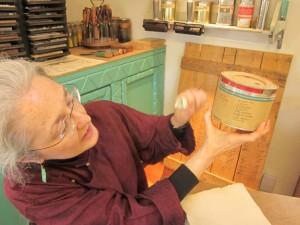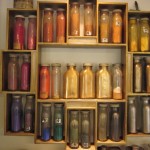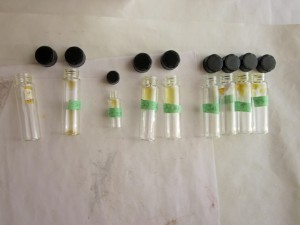 Artist, printmaker and woodworker Gustave Baumann has a well-deserved “beloved” status in Santa Fe, his home for the final 53 years of his life. The Palace Press at the History Museum re-created his studio, using his original materials, tools and furnishings. The New Mexico Museum of Art owns a number of his prints (some of them on display in an exhibit right now) and the replicas and originals of marionettes he carved for theatrical performances.
Artist, printmaker and woodworker Gustave Baumann has a well-deserved “beloved” status in Santa Fe, his home for the final 53 years of his life. The Palace Press at the History Museum re-created his studio, using his original materials, tools and furnishings. The New Mexico Museum of Art owns a number of his prints (some of them on display in an exhibit right now) and the replicas and originals of marionettes he carved for theatrical performances.
So what’s a conservator from Indiana doing here this week prowling around his legacy?
She’s trying to solve a couple of lingering mysteries that Baumann left behind.
The Indianapolis Museum of Art holds a complete set of prints Baumann made during his youthful stint in that state’s Brown County Art Colony, and Claire Hoevel, senior conservator of paper for the museum, wants to find out exactly what his materials were — pigments, bindings, gessos, the fibers in his papers.
“Our hope,” she said, “is to gain a very thorough understanding of Baumann and his processes, how he worked, and his enormous accomplishments. ”
 Thanks to the bottles, cans and jars of materials Baumann left after his 1971 death — materials that are now part of the Palace Press’ exhibit — Hoevel has an opportunity rare in conservator circles.
Thanks to the bottles, cans and jars of materials Baumann left after his 1971 death — materials that are now part of the Palace Press’ exhibit — Hoevel has an opportunity rare in conservator circles.
“It’s an extraordinary thrill for me to come out here and take actual samples,” she said. “Because I can, we won’t have to invade the works themselves. ”
The biggest question she hopes to answer is what Baumann used to bind his pigments.
“It’s important for lovers of Baumann,” she said. “He’s known to have mixed his own paints — a very traditonal process, grinding his own pigments. But the binder he used is a mystery. A vague term is used to describe it, `varnish.’ So, we’re sampling the varnishes here in hopes of cracking this mystery. It would explain why Baumann’s prints and inks look the way they do and how they acted when they went through the process. It was unique to Baumann.”
A sec ondary unsolved question lies in what we might as well call The Mystery of the Disappearing Ink.
ondary unsolved question lies in what we might as well call The Mystery of the Disappearing Ink.
It seems that at one time, one very narrow period of time, Baumann used a particular aqua ink to sign his prints. The signature was visible on the prints when Hoevel’s museum obtained them, but today, it’s gone, vanished, even from prints that were held in dark storage.
“You have a tiny bit of it here,” Hoevel said, showing (at left) a few tablespoons of a whitish powder in a brown bottle from the old Zook’s Pharmacy on the Santa Fe Plaza. “We have remnants of it on other prints — maybe enough for analysis. The big question we have is what was the binder. Then, it’s what the heck was that ink?”
 For her samples, Hoevel puts about an eighth of a teaspoon of each powdered pigment into a vial. Drops of the varnishes were placed in vials that she left open in hopes of evaporating the liquid to make it easier to transport them back to Indiana. A scientist there will test the pigment samples using microfadometry to determine their light tolerance. With that knowledge, the museum officials will know how long they can exhibit Baumann’s pieces and in what kind of lighting. The results may also affect their loan policy.
For her samples, Hoevel puts about an eighth of a teaspoon of each powdered pigment into a vial. Drops of the varnishes were placed in vials that she left open in hopes of evaporating the liquid to make it easier to transport them back to Indiana. A scientist there will test the pigment samples using microfadometry to determine their light tolerance. With that knowledge, the museum officials will know how long they can exhibit Baumann’s pieces and in what kind of lighting. The results may also affect their loan policy.
During her week in Santa Fe, Hoevel’s giving it the full Baumann treatment. She visited the Museum of Art exhibit, The Prints of Gustave Baumann, checked out the Baumann woodblocks held by the History Museum’s Fray Angélico Chávez History Library, and visited the Jane & Gustave Baumann House now owned by the Historic Santa Fe Foundation. Alas, she won’t stay long enough to see the replicas of Baumann’s marionettes perform during the Museum of Art’s Holiday Open House on Dec. 18.
According to Hoevel, folks in Indiana consider Baumann’s Brown County stint as “his formative years. We made him what he is,” she said, jokingly.
During those years, he “did a great number of extraordinary woodblock prints,” though what items will be displayed pending her investigation’s results has yet to be determined by museum curator Martin Krause.
While Hoevel’s work this week in Santa Fe will certainly produce valuable information for Krause, he may be surprised at what other information she brings back.
“I’m trying to pressure him into doing a marionette room,” she said with the slightest of smiles.
